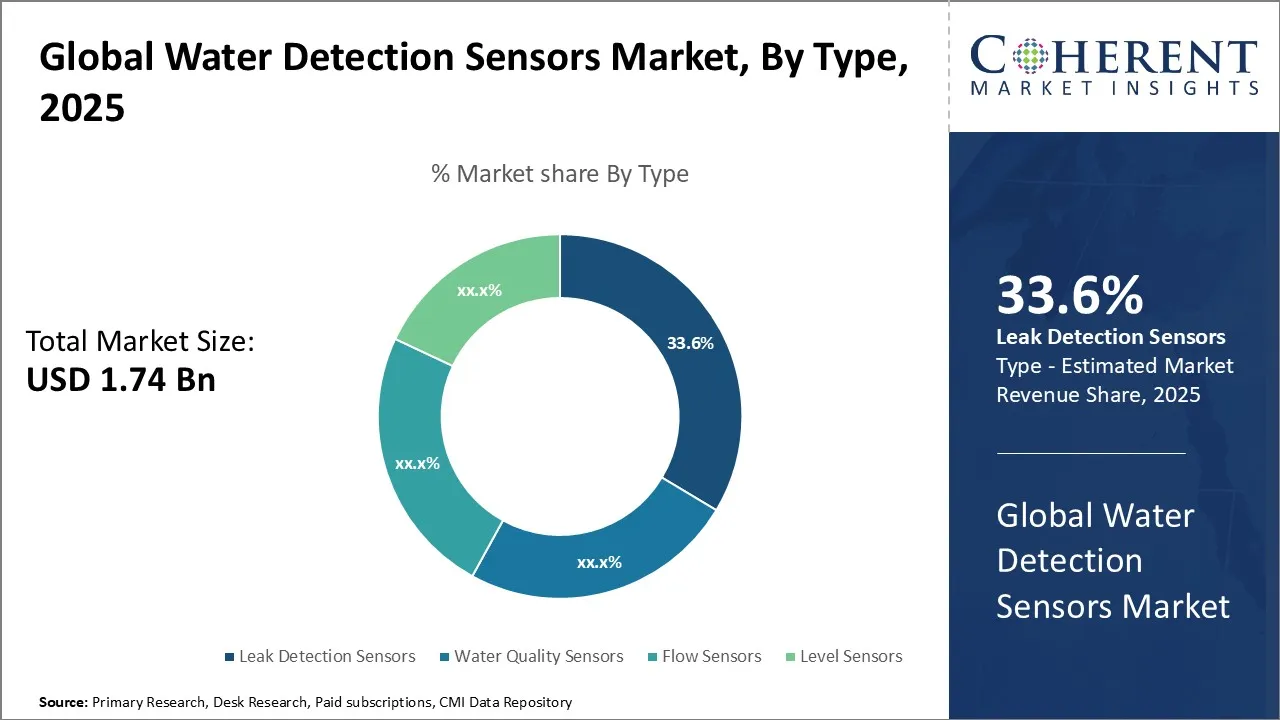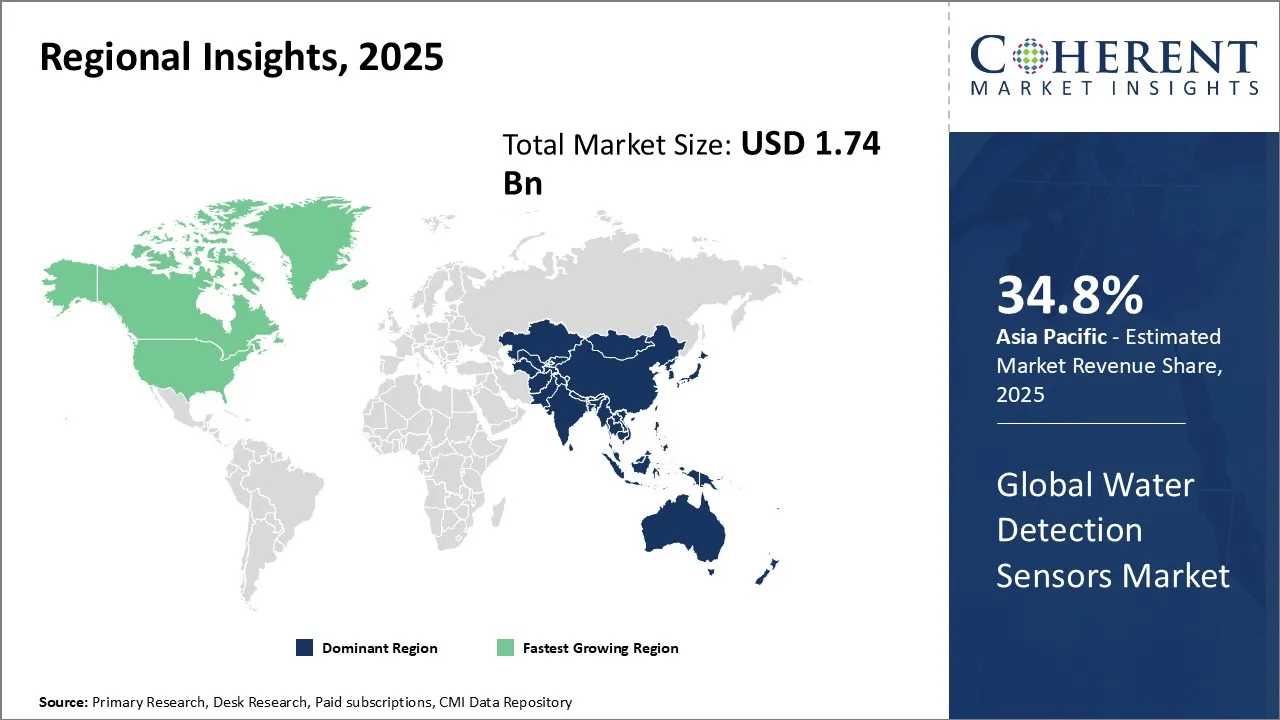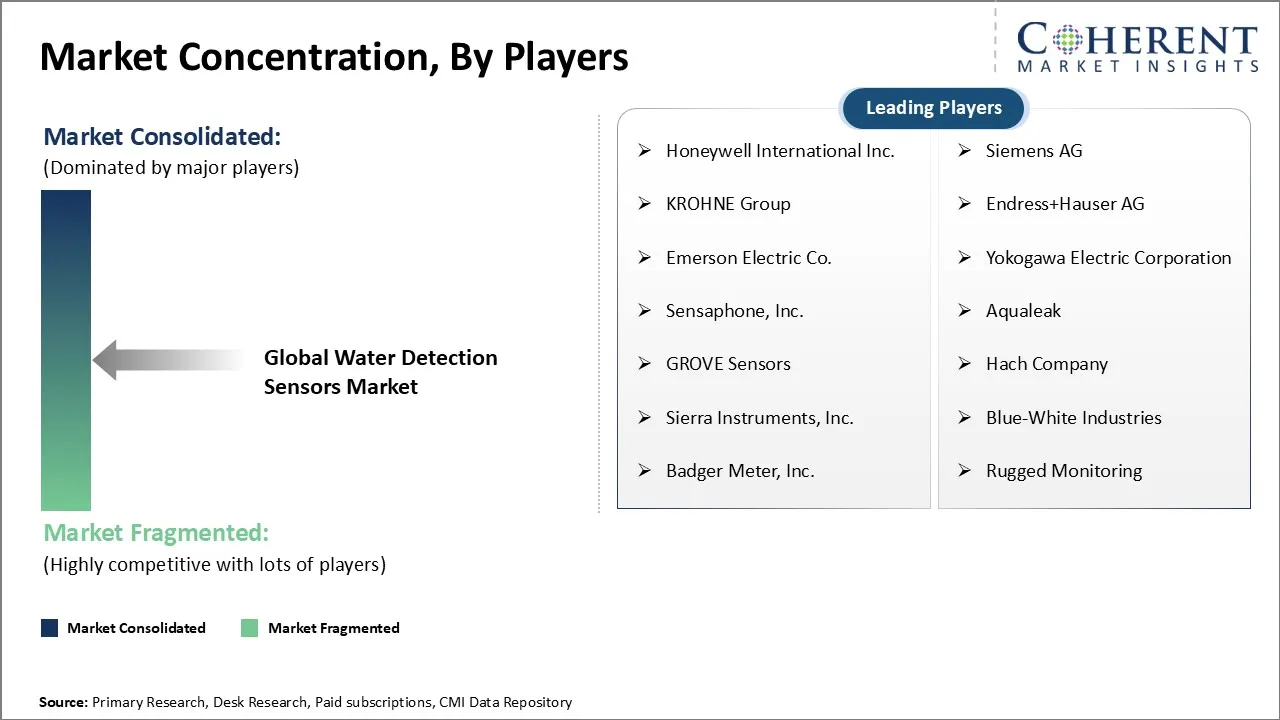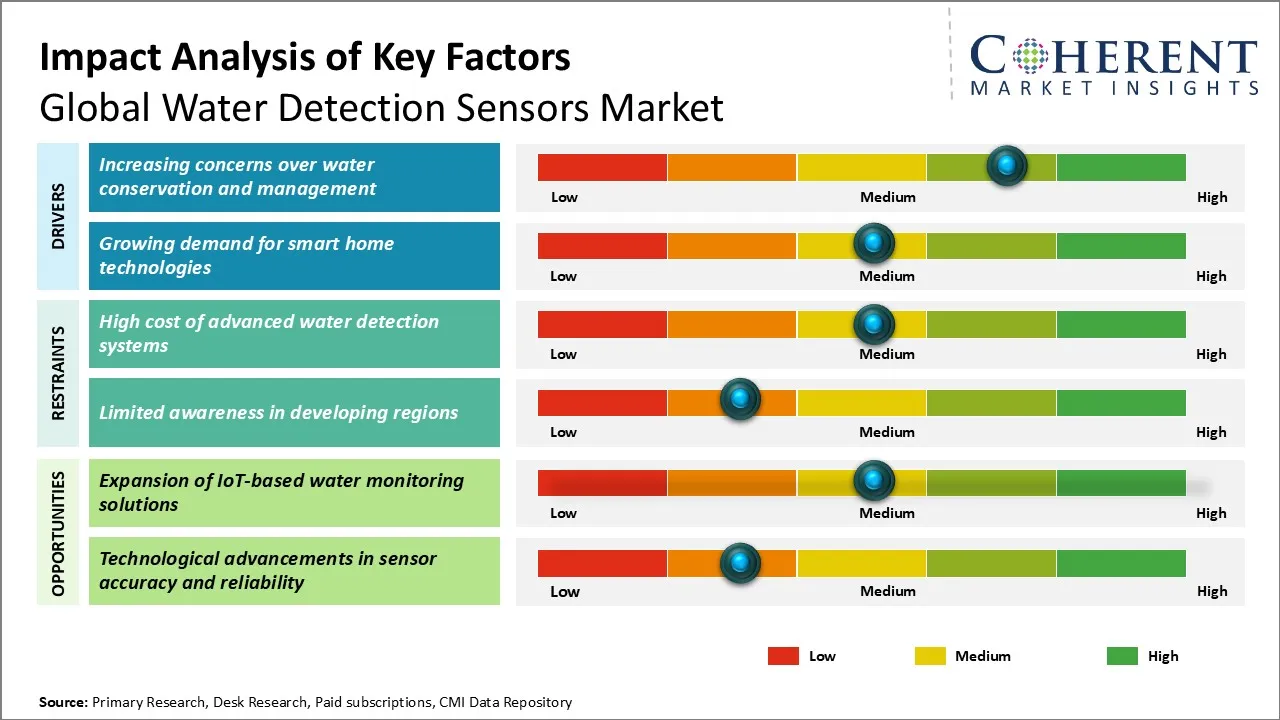Global Water Detection Sensors Market Size and Forecast – 2025-2032
The Global Water Detection Sensors Market is estimated to be valued at USD 1.74 Bn in 2025 and is expected to reach USD 2.73 Bn by 2032, exhibiting a compound annual growth rate (CAGR) of 6.7% from 2025 to 2032.
Key Takeaways of the Water Detection Sensors Market:
- Leak detection sensors are projected to account for 33. 6% of the global water detection sensors market in 2025.
- The chlorine residual sensor segment is expected to hold a 34. 8% share of the market in 2025.
- The ultrasonic segment is projected to dominate the global water detection sensors market in 2025, accounting for a 31. 8% share.
- Asia Pacific is set to lead the global water detection sensors market in 2025 with a 34. 8% share. North America, with a 19.5% share, will be the fastest-growing region.
Market Overview:
In terms of market trends, there is a significant shift towards integrating advanced IoT-enabled water detection sensors that offer real-time monitoring and predictive maintenance capabilities. Companies are focusing on developing highly sensitive, energy-efficient sensors with wireless connectivity to provide seamless alerts and minimize water damage risks. Additionally, increasing urbanization and infrastructural investments are propelling innovative sensor deployment, making water detection solutions essential for sustainable water resource management, smart water management, and disaster prevention strategies globally.
Currents Events and their Impact
|
Current Events |
Description and its impact |
|
Integration of IoT and AI in Water Detection Sensors |
|
|
Technological Advancements in Sensor Capabilities |
|
Uncover macros and micros vetted on 75+ parameters: Get instant access to report
Water Detection Sensors Market Segmental Analysis:

To learn more about this report, Download Free Sample
Water Detection Sensors Market Insights, By Type - Leak Detection Sensors Lead by Ensuring Safe and Efficient Water Management
Leak detection sensors hold an estimated 33.6% share of the global water detection sensors market in 2025, primarily driven by their critical role in preventing water loss and minimizing environmental damage. These sensors are integral to a variety of applications including municipal water supply systems, industrial plants, residential buildings, and agricultural irrigation networks. The rising awareness about water conservation, driven by increasing water scarcity issues worldwide, has significantly elevated the demand for effective leak detection technologies.
Water Detection Sensors Market Insights, By Sensor Type - Chlorine Residual Sensors Lead with Focus on Water Quality and Safety Monitoring
Chlorine residual sensor segment command an estimated 34.8% market share in 2025, largely due to the essential role they play in water quality management. Chlorine is widely used as a disinfectant in municipal water treatment and wastewater management to eliminate harmful pathogens, making the monitoring of residual chlorine levels crucial for public health and regulatory compliance.
The rising global emphasis on safeguarding drinking water quality substantially contributes to the prominence of chlorine residual sensors. These sensors provide continuous, accurate measurement of chlorine levels, ensuring that disinfection processes are effective without leading to excessive chlorine dosage, which can cause taste and odor issues as well as the formation of harmful disinfection by-products. This balance is vital for utilities and water treatment plants aiming to meet stringent water quality standards.
Water Detection Sensors Market Insights, By Technology - Ultrasonic Technology Dominates Due to Precision and Non-Invasive Measurement Capabilities
Ultrasonic segment is expected to lead the global water detection sensors market, accounting for 31.8% share of the market in 2025, by virtue of their precision, reliability, and versatility in diverse water monitoring applications. Ultrasonic technology employs high-frequency sound waves to measure parameters such as water level, flow rate, and the presence of leaks, all without physical contact with the water, which greatly reduces sensor wear and maintenance requirements.
Regional Insights:

To learn more about this report, Download Free Sample
Asia Pacific Water Detection Sensors Market Analysis and Trends
The Asia Pacific region is projected to lead the market with a 34.8% share in 2025 is driven by rapid industrialization, urbanization, and increasing investment in water infrastructure, particularly in emerging economies like China and India. Growing awareness about water scarcity and rising frequency of water-related disasters have prompted governments to support the adoption of advanced water management and monitoring solutions.
Public-private partnerships, government initiatives targeting water resource management, and improving manufacturing capabilities create significant opportunities for water sensor technologies. Major companies, such as Panasonic Corporation, Toshiba Corporation, and Yokogawa Electric Corporation, are leveraging strong regional manufacturing bases and local partnerships to expand their footprint. The expanding trade links within the region and with global players support accelerated technology transfer and market penetration.
North America Water Detection Sensors Market Analysis and Trends
The North America region is expected to exhibit the fastest growth in the market, contributing 19.5% share in 2025, largely driven by a well-established industrial ecosystem, advanced technological infrastructure, and stringent environmental regulations. The region benefits from a mature market with extensive adoption in residential, commercial, and industrial sectors. Government policies emphasizing water conservation and pollution prevention have accelerated the deployment of water detection technologies across sectors such as oil & gas, manufacturing, and municipal water management.
Key players, such as Honeywell International Inc., Emerson Electric Co., and Siemens AG, have significant operations in North America, offering advanced sensor technologies including smart and wireless water detection systems. The well-developed trade networks and strong R&D focus further augment the region’s leadership by encouraging continuous innovation and integration with IoT platforms.
Global Water Detection Sensors Market Outlook for Key Countries
U.S. Water Detection Sensors Market Trends
The U.S. water detection sensors market showcases strong product innovation driven by leading tech firms and sensor manufacturers focusing on smart water detection integrated with IoT and AI capabilities. The country’s robust regulatory environment with agencies like the Environmental Protection Agency (EPA) enforcing water quality standards has increased the demand for reliable detection systems in industrial leak detection and municipal water infrastructure. Companies such as Honeywell and Emerson Electric actively collaborate with regional utilities and industries, strengthening their presence through customized solutions and service networks that ensure effective monitoring and rapid response.
China Water Detection Sensors Market Trends
China’s rapid industrial growth and urban expansion make it a focal point in the Asia Pacific water detection sensors market. The government’s strategic focus on sustainable water management, under initiatives like the “National Water Pollution Control Plan,” drives the demand for innovative detection sensors. Local manufacturers, alongside multinational corporations like Panasonic and Yokogawa, invest heavily in R&D centers aiming at affordable yet high-precision water detection solutions. The country’s strong supply chain and production capabilities enable competitive pricing and widespread availability, fostering broader adoption across manufacturing, agriculture, and municipal sectors.
Germany Water Detection Sensors Market Trends
Germany continues to lead in Europe due to its highly developed industrial base and advanced engineering capabilities supporting the water detection sensors market. Environmental sustainability policies at the EU level, combined with Germany’s commitment to innovative technology, encourage the integration of sensors in manufacturing plants and smart building systems. Siemens and Endress+Hauser AG play pivotal roles, delivering high-accuracy sensors designed for diverse applications, from process industries to water resource management. Germany’s emphasis on Industry 4.0 also promotes the fusion of water detection technologies with digital platforms for predictive maintenance and real-time monitoring.
India Water Detection Sensors Market Trends
India water detection sensors market is marked by growing government initiatives targeting water conservation and disaster management, such as the “Smart Cities Mission” and irrigation modernization schemes. These initiatives drive demand for cost-effective water detection technologies adaptable to rural and urban settings. Major players including local firms and multinational companies like ABB Ltd. collaborate on developing scalable solutions tailored to India’s infrastructure challenges. Increasing awareness of water leak detection in residential and commercial buildings also fuels market expansion, supported by improving trade relations and technology adoption.
Brazil Water Detection Sensors Market Trends
Brazil’s emerging water detection sensors market benefits from the country’s abundant water resources and growing industrial sector requiring effective leak detection and flood prevention systems. Environmental regulations aimed at protecting significant river basins and urban water supplies encourage adoption. Companies such as Schneider Electric and local sensor manufacturers focus on deploying reliable solutions for mining, agriculture, and municipal water applications. Despite infrastructure challenges, increasing investments and partnerships with international technology providers contribute to the gradual strengthening of Brazil’s market position within Latin America.
Macro and Micro Economic factors impacting on Water Detection Sensors Market:
Macro-Economic Factors:
- Global Water Scarcity: Over 40% of the global population experiences water scarcity, intensifying demand for conservation technologies like leak detection sensors.
- Government Regulations: Strict environmental policies and building codes mandate water monitoring in critical infrastructure (e.g., hospitals, data centers), accelerating market adoption.
- Economic Uncertainties: Budget constraints during downturns may delay investments, though rising water damage costs (e.g., average insurance claims of USD11,098) incentivize preventive spending.
Micro Economic Factors
- Technological Innovation: IoT and AI integration enable real-time monitoring, predictive maintenance, and cloud-based analytics. Wireless connectivity and miniaturization reduce installation costs and expand applications.
- Cost and Competition: High initial costs and lack of standardization hinder adoption, but competitive pricing and partnerships (e.g., sensor manufacturers with IoT platforms) mitigate barriers.
Market Players, Key Development, and Competitive Intelligence:

To learn more about this report, Download Free Sample
Key Developments:
- In February 2025, LAIIER announced a strategic partnership with Cox Engineering to advance smart water leak detection solutions. LAIIER, an innovative provider of liquid leak detection using smart tape technology, is joining forces with Cox Engineering, an award-winning leader in metal and mechanical services. The collaboration aims to deliver enhanced, scalable leak detection capabilities for commercial and industrial facilities.
Top Strategies Followed by Global Water Detection Sensors Market Players
- Established players: Established companies in this sector often rely heavily on significant investments in research and development (R&D) to drive innovation in high-performance water detection solutions. These investments enable them to enhance sensor accuracy, durability, and energy efficiency, meeting stringent industry standards and customer demands. Furthermore, these market leaders strategically forge partnerships and collaborations with other major industry players and original equipment manufacturers (OEMs).
- For example, Honeywell has developed advanced water leak detection systems equipped with wireless sensing and real-time monitoring capabilities for commercial facilities, while Siemens integrates smart water sensors into its industrial automation platforms to improve plant safety and efficiency.
- Mid-level players in the water detection sensors market pursue a distinct strategy focused on delivering cost-effective solutions that balance quality with affordability. By catering to price-sensitive customers, these companies attract small and medium-sized enterprises, residential users, and emerging markets that need dependable yet economical water detection technologies. To strengthen their market position, mid-tier firms often form partnerships with technology providers, contract manufacturers, or regional distributors.
- For example, Dorlen Products Inc. offers economical water leak detection alarm systems widely used in server rooms, libraries, and data centers where affordability is crucial. To enhance their competitiveness, mid-tier companies frequently engage in collaborations with technology providers, contract manufacturers, or regional distributors.
- Small-scale players: Small-scale players in the global water detection sensors market often carve out their competitive niche by emphasizing specialized features or unique innovative products that differentiate them from mainstream offerings. These companies frequently adopt cutting-edge technologies such as IoT integration, AI-based predictive analytics, or novel sensor materials to stay competitive despite limited resources.
- For instance, LeakSmart has developed an intelligent system that detects water leaks and automatically shuts off the water supply, which is highly valued in residential applications. WaterCop offers smart valve systems integrated with wireless leak sensors for property protection, while FloLogic uses AI-powered flow sensing to proactively detect leaks and anomalies in plumbing systems.
Market Report Scope
Water Detection Sensors Market Report Coverage
| Report Coverage | Details | ||
|---|---|---|---|
| Base Year: | 2024 | Market Size in 2025: | USD 1.74 Bn |
| Historical Data for: | 2020 To 2024 | Forecast Period: | 2025 To 2032 |
| Forecast Period 2025 to 2032 CAGR: | 6.7% | 2032 Value Projection: | USD 2.73 Bn |
| Geographies covered: |
|
||
| Segments covered: |
|
||
| Companies covered: |
Honeywell International Inc., Siemens AG, KROHNE Group, Endress+Hauser AG, Emerson Electric Co., Yokogawa Electric Corporation, Sensaphone, Inc., Aqualeak, GROVE Sensors, Hach Company, Sierra Instruments, Inc., Blue-White Industries, Badger Meter, Inc., and Rugged Monitoring |
||
| Growth Drivers: |
|
||
| Restraints & Challenges: |
|
||
Uncover macros and micros vetted on 75+ parameters: Get instant access to report
Water Detection Sensors Market Dynamics

To learn more about this report, Download Free Sample
Water Detection Sensors Market Driver - Increasing Concerns Over Water Conservation and Management
Rising awareness about the critical importance of preserving water resources has significantly amplified the focus on water ecological restoration conservation and management practices worldwide. With growing populations, urbanization, and climate change accelerating water scarcity issues, governments, industries, and environmental agencies are prioritizing efficient water usage and leak detection to minimize wastage. Water detection sensors play a vital role in early identification of leaks and overflows in residential, commercial, and industrial settings, enabling timely intervention and reducing water loss.
For instance, smart cities are increasingly deploying sensor networks throughout their water distribution systems to identify leaks in real-time, preventing significant water losses that traditionally went undetected for extended periods. The European Union's Water Framework Directive and similar regulations in North America mandate continuous monitoring of water resources, creating substantial demand for sophisticated sensor technologies that can provide accurate, real-time data for compliance reporting and resource management decisions.
Water Detection Sensors Market Opportunity - Expansion of IoT-Based Water Monitoring Solutions
The global water detection sensors market stands to benefit significantly from the rapid expansion of Internet of Things (IoT)-based water monitoring solutions. As urbanization accelerates and water scarcity concerns intensify, there is a growing demand for smart water management systems that provide real-time data and predictive analytics. Integration of water detection sensors with IoT devices platforms enables continuous monitoring of water quality, leakage, flow rates, and contamination levels, facilitating proactive maintenance and efficient resource utilization. This connectivity not only improves operational efficiency for municipal water authorities and industrial users but also enhances consumer awareness and engagement in water conservation efforts.
For example, smart cities like Barcelona have implemented comprehensive IoT water networks that use interconnected sensors to monitor water quality across distribution systems, enabling immediate response to contamination incidents and optimizing water treatment processes.
Analyst Opinion (Expert Opinion):
- The water detection sensors market is poised for significant expansion, driven by escalating concerns over water leaks and potential damage in both residential and industrial settings. Companies like Honeywell and GROVE are at the forefront, developing advanced sensors that provide real-time monitoring and alerts, enhancing preventative maintenance practices. Recent conferences, such as the Water Loss Conference (2023) and the International Conference on Smart Water Management (2022), have highlighted the critical role of innovative sensor technologies in mitigating water loss and improving resource management.
- These events showcased case studies where the implementation of smart detection solutions has led to substantial cost savings and reduced environmental impact. As industries and homeowners increasingly prioritize water conservation and damage prevention, the water detection sensors market is well-positioned for growth, driven by innovations that meet the demands of a more connected and sustainability-focused world.
Market Segmentation
- Type Insights (Revenue, USD Bn, 2020 - 2032)
-
- Leak Detection Sensors
- Water Quality Sensors
- Flow Sensors
- Level Sensors
- Sensor Type Insights (Revenue, USD Bn, 2020 - 2032)
-
- Chlorine Residual Sensor
- pH Sensor
- TOC Sensor
- ORP Sensor
- Conductivity Sensor
- Others
- Technology Insights (Revenue, USD Bn, 2020 - 2032)
-
- Ultrasonic
- Capacitive
- Optical
- Conductivity
- Application Insights (Revenue, USD Bn, 2020 - 2032)
-
- Residential
- Commercial
- Industrial
- Agricultural
- Regional Insights (Revenue, USD Bn, 2020 - 2032)
- North America
- U.S.
- Canada
- Latin America
- Brazil
- Argentina
- Mexico
- Rest of Latin America
- Europe
- Germany
- U.K.
- Spain
- France
- Italy
- Russia
- Rest of Europe
- Asia Pacific
- China
- India
- Japan
- Australia
- South Korea
- ASEAN
- Rest of Asia Pacific
- Middle East
- GCC Countries
- Israel
- Rest of Middle East
- Africa
- South Africa
- North Africa
- Central Africa
- North America
- Key Players Insights
- Honeywell International Inc.
- Siemens AG
- KROHNE Group
- Endress+Hauser AG
- Emerson Electric Co.
- Yokogawa Electric Corporation
- Sensaphone, Inc.
- Aqualeak
- GROVE Sensors
- Hach Company
- Sierra Instruments, Inc.
- Blue-White Industries
- Badger Meter, Inc.
- Rugged Monitoring
Sources:
Primary Research Interviews:
- R&D Head – Leading Leak Detection Sensor Manufacturer
- Product Manager – Major Building Automation Systems Provider
- Procurement Director – Water Utilities Company
- Technology Head – Smart Home Devices Manufacturer
Stakeholders:
- Manufacturers
- End-use Sectors:
- Commercial Buildings (offices, malls, hospitals)
- Residential Smart Homes
- Industrial Facilities (chemical, food processing, data centers)
- Regulatory & Certification Bodies
- System Integrators & Distributors
- IoT Platform Providers enabling sensor connectivity
Databases:
- UN Comtrade Database
- India Import Export (EXIM) Database
- International Energy Agency (IEA) Smart Water Data
- U.S. Geological Survey (USGS) Water Data
Magazines:
- Water & Wastewater International – Developments in water monitoring technologies
- Smart Water Magazine – Innovations in leak detection and smart metering
- Industrial WaterWorld – Case studies of industrial water monitoring
- IoT Now – IoT integration in water detection systems
- Buildings Magazine – Trends in commercial water detection solutions
Journals:
- Sensors and Actuators B: Chemical – Research on sensor technologies for water detection
- Journal of Water Resources Planning and Management – Leak detection methods and best practices
- IEEE Internet of Things Journal – IoT-based water leak detection solutions
- Journal of Hydrology – Monitoring techniques for water loss prevention
- Measurement – Advances in ultrasonic and capacitance sensor applications
Newspapers
- The Wall Street Journal – Investments in smart water infrastructure
- The Guardian – Water conservation initiatives and regulatory policies
- Asia Water News – Smart water management projects in Asia-Pacific
- The Economic Times – Adoption of leak detection systems in India
- The New York Times – Water scarcity and technology-enabled conservation
Associations:
- American Water Works Association (AWWA)
- Water Environment Federation (WEF)
- International Water Association (IWA)
- Smart Water Networks Forum (SWAN)
- European Water Association (EWA)
- IoT M2M Council
Public Domain Sources
- U.S. Environmental Protection Agency (EPA) – Guidelines for water conservation technologies
- European Commission – Water Framework Directive & IoT implementation guidance
- World Health Organization – Water safety and monitoring standards
- International Organization for Standardization (ISO) – Sensor performance standards
- OECD – Reports on sustainable water management
Proprietary Elements:
- CMI Data Analytics Tool, Proprietary CMI Existing Repository of information for last 8 years.
Share
Share
About Author
As an accomplished Senior Consultant with 7+ years of experience, Pooja Tayade has a proven track record in devising and implementing data and strategy consulting across various industries. She specializes in market research, competitive analysis, primary insights, and market estimation. She excels in strategic advisory, delivering data-driven insights to help clients navigate market complexities, optimize entry strategies, and achieve sustainable growth.
Missing comfort of reading report in your local language? Find your preferred language :
Transform your Strategy with Exclusive Trending Reports :
Frequently Asked Questions
EXISTING CLIENTELE
Joining thousands of companies around the world committed to making the Excellent Business Solutions.
View All Our Clients

